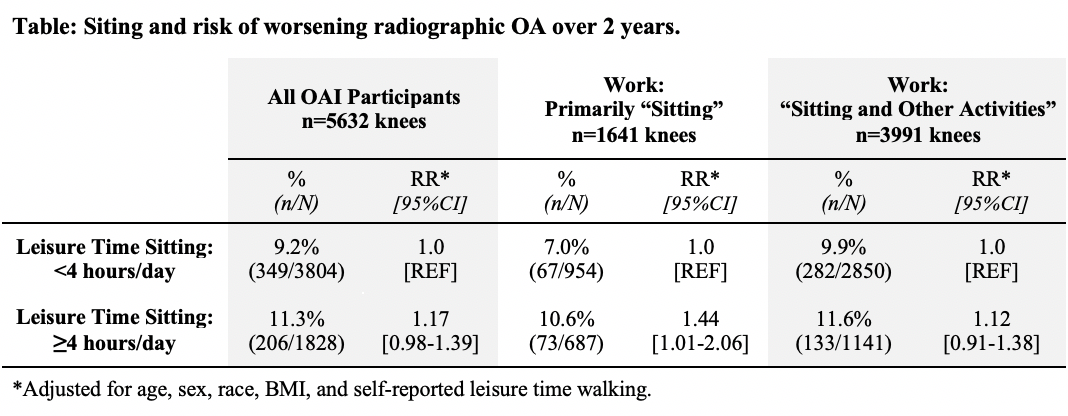Session Information
Session Type: ACR/ARP Abstract Session
Session Time: 11:00AM-12:30PM
Background/Purpose: Sitting is associated with many poor health outcomes, which may include knee osteoarthritis (OA). When the knee is subject to minimal load, knee cartilage becomes thinner and may be more susceptible to damage. Thus, people who spend more time in sitting, whether during leisure time or during work, may be at greater risk for worsening structural damage in the knee. We examined the relation of time sitting to worsening radiographic OA over 2 years in a cohort of adults with or at risk for knee OA, assessing time spent sitting during leisure time and at work separately. We hypothesized that people with more leisure-time sitting and more sitting at work are at greater risk for worsening radiographic OA.
Methods: We used data from the Osteoarthritis Initiative (OAI). At study baseline, participants reported their leisure time sitting (hours/day) via the Physical Activity Scale for the Elderly (PASE). We dichotomized leisure time sitting as < 4 hours/day vs ≥4 hours/day, as this was the approximate mean for the sample. Participants also reported their work activities via the PASE as: sitting, sitting/standing/walking, walking/handling < 50 lbs, or walking/handling >50 lbs. We dichotomized work activities as “sitting only” vs “sitting and other activities”. All OAI participants had bilateral knee radiographs obtained and scored for Kellgren and Lawrence (KL) grade at baseline, 1-year, and 2-year follow-up visits. We defined our outcome, worsening radiographic OA over 2 years, as an increase in KL grade from baseline to end of follow-up, including within-grade changes. We examined the relation of leisure time sitting with worsening radiographic OA using binomial regression with GEE, adjusting for potential confounders (age, sex, race, body mass index [BMI], and self-reported leisure time walking [hours/day]). We then repeated analyses of the effect of leisure time sitting on worsening ROA among those whose work involves “sitting only” and separately among those whose work involves “sitting and other activities”.
Results: We included 5632 knees in our analysis (2826 participants, BMI: 28.4 ± 4.8 kg/m2, age: 59.4 ± 8.6 years, 57% women, 83% white). People who spent ≥ 4 hours/day in leisure time sitting had greater risk (1.17[0.98-1.39]) of worsening radiographic OA over 2 years, compared with those who spent < 4 hours/day in leisure time sitting. Among participants who reported “sitting only” at work, those who spent ≥4 hours/day in leisure time sitting had greater risk (1.44[1.01-2.06] of worsening radiographic OA compared with those who spent < 4 hours/day in leisure time sitting. Conversely, among participants who reported “sitting and other activities” at work, there was no relationship between leisure time sitting and worsening radiographic OA (see Table).
Conclusion: People who spend at least 4 hours/day of leisure time sitting, and also primarily sit at work, may be at increased risk for worsening radiographic OA. Reducing leisure time sitting, and potentially reducing sitting at work, may be targets for intervention in people with or at risk for knee OA.
To cite this abstract in AMA style:
Voinier D, Neogi T, Master H, Thoma L, Christiansen M, Jakiela J, Neely L, White D. The Effects of Leisure Time Sitting and Sitting at Work on Worsening Radiographic Knee Osteoarthritis over Two Years: Data from the Osteoarthritis Initiative [abstract]. Arthritis Rheumatol. 2019; 71 (suppl 10). https://acrabstracts.org/abstract/the-effects-of-leisure-time-sitting-and-sitting-at-work-on-worsening-radiographic-knee-osteoarthritis-over-two-years-data-from-the-osteoarthritis-initiative/. Accessed .« Back to 2019 ACR/ARP Annual Meeting
ACR Meeting Abstracts - https://acrabstracts.org/abstract/the-effects-of-leisure-time-sitting-and-sitting-at-work-on-worsening-radiographic-knee-osteoarthritis-over-two-years-data-from-the-osteoarthritis-initiative/

